Milwaukee 2360-20 Handleiding
Bekijk gratis de handleiding van Milwaukee 2360-20 (12 pagina’s), behorend tot de categorie Zaklamp. Deze gids werd als nuttig beoordeeld door 90 mensen en kreeg gemiddeld 4.6 sterren uit 45.5 reviews. Heb je een vraag over Milwaukee 2360-20 of wil je andere gebruikers van dit product iets vragen? Stel een vraag
Pagina 1/12

Cat. No. / No de cat.
2360-20
M18™ LED HP FLOOD LIGHT
ÉCLAIRAGE PAR PROJECTION HP À DEL M18™
REFLECTOR LED HP M18™
OPERATOR'S MANUAL
MANUEL de L'UTILISATEUR
MANUAL del OPERADOR
WARNING To reduce the risk of injury, user must read and understand operator's manual.
AVERTISSEMENT An de réduire le risque de blessures, l'utilisateur doit lire et bien
comprendre le manuel.
ADVERTENCIA Para reducir el riesgo de lesiones, el usuario debe leer y entender el manual.

2
IMPORTANT SAFETY
INSTRUCTIONS
WARNING
Read all safety warnings and all
instructions. Failure to follow the
warnings and instructions may result in electric
shock, re and/or serious injury. Save all warnings
and instructions for future reference.
WORK AREA SAFETY
• To reduce the risk of injury, close supervision is
necessary when an appliance is used near children.
• Store idle light out of reach of children. Warm
lights can become hazardous in the hands of chil-
dren.
• Do not use outdoors.
ELECTRICAL SAFETY
• Power cord plugs must match the outlet. Never
modify the plug in any way. Do not use any
adapter plugs with earthed (grounded) power
tools. Unmodied plugs and matching outlets will
reduce risk of electric shock.
• Avoid body contact with earthed or grounded
surfaces, such as pipes, radiators, ranges and
refrigerators. There is an increased risk of electric
shock if your body is earthed or grounded.
• Do not expose light to rain or wet conditions.
Water entering a light will increase the risk of electric
shock.
• To reduce the risk of electric shock, do not put light
in water or other liquid. Do not place or store appli-
ance where it can fall or be pulled into a tub or sink.
• Do not abuse the cord. Never use the cord for
carrying, pulling or unplugging the power tool.
Keep cord away from heat, oil, sharp edges
or moving parts. Damaged or entangled cords
increase the risk of electric shock.
• Do not unplug by pulling on the cord. To unplug,
grasp the plug, not the cord.
• Unplug the cord from outlet when not in use and
before servicing or cleaning.
• Always use a suitable extension cord to reduce
the risk of electric shock.
• If operating a light in a damp location is unavoid-
able, use a ground fault circuit interrupter (GFCI)
protected supply. Use of an GFCI reduces the risk
of electric shock.
PERSONAL SAFETY
• Do not overreach. Keep proper footing and bal-
ance at all times. This enables better control of the
light in unexpected situations.
• Do not use on a ladder or unstable support.
Stable footing on a solid surface enables better
control of the light in unexpected situations.
• Do no stare at the operating light source.
BATTERY TOOL USE AND CARE
• Recharge only with the charger specied by the
manufacturer. A charger that is suitable for one type
of battery pack may create a risk of re when used
with another battery pack.
• Use light only with specically designated bat-
tery packs. Use of any other battery packs may
create a risk of injury and re.
• When battery pack is not in use, keep it away
from other metal objects, like paper clips, coins,
keys, nails, screws or other small metal objects,
that can make a connection from one terminal
to another. Shorting the battery terminals together
may cause burns or a re.
• Under abusive conditions, liquid may be ejected
from the battery; avoid contact. If contact acci-
dentally occurs, ush with water. If liquid con-
tacts eyes, additionally seek medical help. Liquid
ejected from the battery may cause irritation or burns.
• Do not use a battery pack or tool that is dam-
aged or modied. Damaged or modied batteries
may exhibit unpredictable behavior resulting in re,
explosion or risk of injury.
• Do not expose a battery pack or tool to re or
excessive temperature. Exposure to re or tem-
perature above 265°F (130°C) may cause explosion.
• Follow all charging instructions and do not
charge the battery pack or tool outside the
temperature range specied in the instructions.
Charging improperly or at temperatures outside
the specied range may damage the battery and
increase the risk of re.
SERVICE
• Have your light serviced by a qualied repair
person using only identical replacement parts.
This will ensure that the safety of the light is main-
tained.
• Never service damaged battery packs. Service
of battery packs should only be performed by
the
manufacturer or authorized service providers.
SPECIFIC SAFETY RULES
• Maintain labels and nameplates. These carry im-
portant information. If unreadable or missing, contact
a MILWAUKEE service facility for a free replacement.
•
WARNING
Some dust created by power
sanding, sawing, grinding, drilling,
and other construction activities contains
chemicals known to cause cancer, birth defects
or other reproductive harm. Some examples of
these chemicals are:
• lead from lead-based paint
• crystalline silica from bricks and cement and other
masonry products, and
• arsenic and chromium from chemically-treated lumber.
Your risk from these exposures varies, depending on
how often you do this type of work. To reduce your
exposure to these chemicals: work in a well ventilated
area, and work with approved safety equipment, such
as those dust masks that are specially designed to
lter out microscopic particles.
SYMBOLOGY
Volts
Direct Current
Alternating Current
Double Insulated
Do not stare at the operating light
source
C US
UL Listing for Canada and U.S.

3
SPECIFICATIONS
Cat. No. 2360-20 .....................................................
AC Input Volts ....................................................120
DC Input Volts 18......................................................
Max AC Input Amps ...............................................1
Max DC Input Amps............................................2.5
Hertz ....................................................................60
GROUNDING
WARNING
Improperly connecting the ground-
ing wire can result in the risk of electric shock.
Check with a qualied electrician if you are in
doubt as to whether the outlet is properly
grounded. Do not modify the plug provided with
the tool. Never remove the grounding prong from
the plug. Do not use the tool if the cord or plug
is damaged. If damaged, have it repaired by a
MILWAUKEE service facility before use. If the
plug will not t the outlet, have a proper outlet
installed by a qualied electrician.
Grounded Tools (Three-Prong Plugs)
Tools marked “Grounding Required” have a three
wire cord and three prong grounding plug. The plug
must be connected to a properly grounded outlet
(See Figure A). If the tool should electrically mal-
function or break down, grounding provides a low
resistance path to carry electricity away from the
user, reducing the risk of electric shock.
The grounding prong in the plug is connected through
the green wire inside the cord to the grounding
system in the tool. The green wire in the cord must
be the only wire connected to the tool's grounding
system and must never be attached to an electrically
“live” terminal.
Your tool must be plugged into an appro-
Fig. A
priate outlet, properly installed and
grounded in accordance with all codes
and ordinances. The plug and outlet
should look like those in Figure A.
Double Insulated Tools (Two-Prong Plugs)
Tools marked “Double Insulated” do not require
grounding. They have a special double insulation
system which satises OSHA requirements and
complies with the applicable standards
Fig. B Fig. C
of Underwriters Laboratories, Inc., the
Canadian Standard Association and
the National Electrical Code. Double
Insulated tools may be used in either
of the 120 volt outlets shown in Figures
B and C.
EXTENSION CORDS
Grounded tools require a three wire extension
cord. Double insulated tools can use either a two
or three wire extension cord. As the distance from
the supply outlet increases, you must use a heavier
gauge extension cord. Using extension cords with
inadequately sized wire causes a serious drop in
voltage, resulting in loss of power and possible tool
damage. Refer to the table shown to determine the
required minimum wire size.
The smaller the gauge number of the wire, the greater
the capacity of the cord. For example, a 14 gauge
cord can carry a higher current than a 16 gauge cord.
When using more than one extension cord to make
up the total length, be sure each cord contains at
least the minimum wire size required. If you are using
one extension cord for more than one tool, add the
nameplate amperes and use the sum to determine
the required minimum wire size.
Guidelines for Using Extension Cords
• If you are using an extension cord outdoors, be sure
it is marked with the sux “W-A” (“W” in Canada)
to indicate that it is acceptable for outdoor use.
• Be sure your extension cord is properly wired
and in good electrical condition. Always replace a
damaged extension cord or have it repaired by a
qualied person before using it.
• Protect your extension cords from sharp objects,
excessive heat and damp or wet areas.
Recommended Minimum Wire Gauge
For Extension Cords*
Nameplate Amps
Extension Cord Length
25' 50' 75' 100' 150'
0 - 2.0
2.1 - 3.4
3.5 - 5.0
5.1 - 7.0
7.1 - 12.0
12.1 - 16.0
16.1 - 20.0
18
18
18
18
16
14
12
18
18
18
16
14
12
10
18
18
16
14
12
10
--
18
16
14
12
10
--
--
16
14
12
12
--
--
--
* Based on limiting the line voltage drop to ve volts at 150%
of the rated amperes.
READ AND SAVE ALL INSTRUCTIONS
FOR FUTURE USE.
ASSEMBLY
WARNING
Recharge only with the charger
specied for the battery. For spe-
cic charging instructions, read the operator’s
manual supplied with your charger and battery.
Inserting/Removing the Battery
Insert the battery pack by sliding battery pack into
the body of the tool. Insert the battery pack until the
battery latches lock.
To remove the battery pack, press in both battery
latches and slide the battery pack o of the tool.
Inserting/Removing Power Cord
To operate on AC power, plug in a suitable extension
cord to the receptacle. To remove, unplug the exten-
sion cord from the receptacle.
Product specificaties
| Merk: | Milwaukee |
| Categorie: | Zaklamp |
| Model: | 2360-20 |
Heb je hulp nodig?
Als je hulp nodig hebt met Milwaukee 2360-20 stel dan hieronder een vraag en andere gebruikers zullen je antwoorden
Handleiding Zaklamp Milwaukee
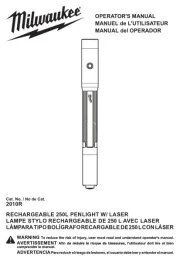
15 Juli 2025
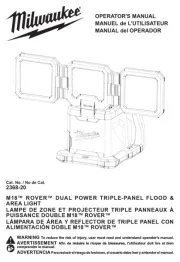
14 Juli 2025
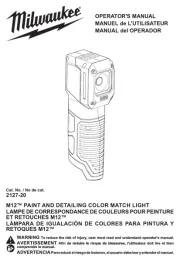
14 Juli 2025
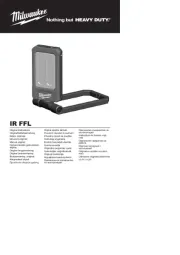
14 Juli 2025

10 April 2024

10 April 2024

10 April 2024

10 April 2024

10 April 2024

10 April 2024
Handleiding Zaklamp
- Nitecore
- NightStick
- HQ
- Velleman
- Life Gear
- Gorenje
- EverActive
- Maverick
- Powerfix
- Total
- Einhell
- Silverline
- Pyle
- Goal Zero
- Maglite
Nieuwste handleidingen voor Zaklamp
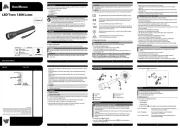
16 Juli 2025
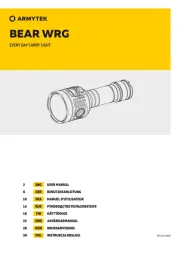
14 Juli 2025
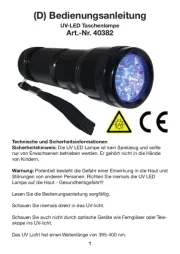
10 Juli 2025
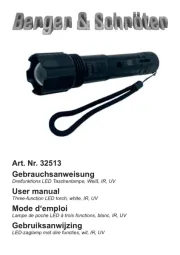
5 Juli 2025
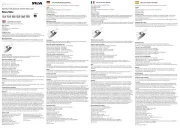
4 Juli 2025
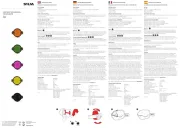
4 Juli 2025

3 Juli 2025

3 Juli 2025
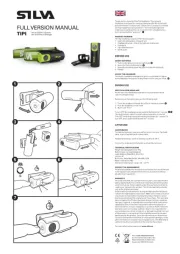
3 Juli 2025

2 Juli 2025